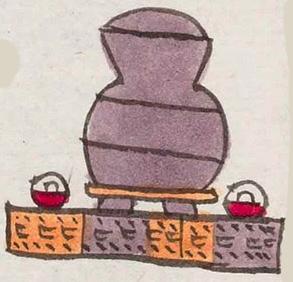Cuezcomaixtlahuacan (Mdz16r)
This compound glyph for the place name Cuezcomaixtlahuacan has three notable elements. At the top is a purple granary for maize storage (cuezcomatl). It has a possible ceramic look to it, with a flat lid and horizontal lines. It sits atop a plain (ixtlahuatl) that is segmented and textured, colored alternating orange and purple. Red and white upside down eyes sit atop the plain.
Stephanie Wood
The eyes (ixtli) are there as a phonetic indicator to underscore the reading of ixtlahuatl) (plains) as opposed to, for instance, tlalli (land). Berdan and Anawalt have suggested that the eyes are intentionally upside down to call forth īxtlapal, which sounds like ixtlahuatl. But Frances Karttunen says that īxtlapal is closer to "sideways" than "reversed" or "inverted." So, she supports the reading that the eyes (ixtli) provide the ix- starting sound for the plains (ixtlahuatl). (Source: Frances Karttunen, "Critique of glyph catalogue in Berdan and Anawalt edition of Codex Mendoza," unpublished manuscript.)
It is difficult to determine whether this granary bin for storing maize was wooden or ceramic. The lid with the handle looks somewhat like molded ceramic. Some cuezcomates are purple and some are orange in this collection. Perhaps with further research it will become clearer why the colors vary so much. Some have stones under them, and some do not.
Sometimes a cuezcomatl was large enough to have its own solid foundation, as has been indicated in archaeological studies of household compounds. See, for example, Deborah L. Nichols and Christopher A. Pool, The Oxford Handbook of Mesoamerican Archaeology (2012), p. 920. One can also see surviving cuezcomatl in places such as Morelos today, where they typically have a thatched roof. A manuscript from Huexotzinco also shows a thatched cuezcomatl.
James Lockhart, as cited in our online dictionary (mentioned elsewhere in this record), wondered whether the term cuezcomatl had a relationship to comitl. But some sources also refer to wooden corncribs. A wooden cuezcomate with a thatched roof can be seen in the Huexotzinco Codex, as published in our Mapas Project. Cuezcomates can still be found in some places in central Mexico, as seen here in Morelos. As a storage site for the most basic staple of the Nahua diet, it may have had an association with fertility and life as babies were sometimes buried by the cuezcomatl, according to the Florentine Codex, Book 6. And, in Book 2, ears of corn in the granary could symbolize hearts. (Both examples are cited in our dictionary, too.) Finally, the Mexicolore site has a page with various images of cuezcomates (in Spanish).
Stephanie Wood
cuezcomayxtlahuacā, puo
Cuezcomaixtlahuacan, pueblo
Stephanie Wood
c. 1541, or by 1553 at the latest
Stephanie Wood
corn, maize, granary, grain storage, plain, plains, eyes, almacenes, maíz, cuezcomates, cuexcomates, nombres de lugares

cuezcoma(tl), maize storage container or granary, https://nahuatl.wired-humanities.org/content/cuezcomatl
ix(tli), eye, https://nahuatl.wired-humanities.org/content/ixtli
ixtlahua(tl), plains, https://nahuatl.wired-humanities.org/content/ixtlahuatl
-can, https://nahuatl.wired-humanities.org/content/can-2
"Place of the Plain of Granaries" (Berdan and Anawalt, 1992, vol. 1, p. 183)
Codex Mendoza, folio 16 recto, https://digital.bodleian.ox.ac.uk/objects/2fea788e-2aa2-4f08-b6d9-648c00..., image 42 of 188.
The Bodleian Libraries, University of Oxford, hold the original manuscript, the MS. Arch. Selden. A. 1. This image is published here under the UK Creative Commons, “Attribution-NonCommercial-ShareAlike 3.0 License” (CC-BY-NC-SA 3.0).





